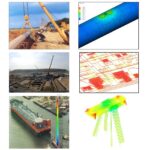Corrosion is one of the main causes of failures in the Oil & Gas industry. Cetim’s failure analysis experts, including Alexandre Romaine – corrosion engineer, help manufacturers to manage this complex issue.
.
What are the main dangers related to corrosion in the Oil & Gas industry?
Alexandre Romaine: Corrosion accounts for a large proportion of material failures in this sector. One major contributor is aggressive fluids containing hydrogen sulphide (H2S) and Carbon dioxide (CO2). For example, hydrogen sulphide causes hydrogen embrittlement of materials, which can lead to fractures. Nevertheless, corrosion is a complex process that can arise from many sources and it is vitally important to identify its nature in order to prevent the risks of failure. Welds are also very susceptible to corrosion in this sector and require special attention.
These effects can be minimised by the choice of materials, design, assembly processes and their proper implementation, as well as by the use of tubes (casing, tubing and pipeline). The two main challenges involve identifying and qualifying the right materials in operating conditions in order to guarantee the safety of installations, while reducing production costs.
What about the prevention of corrosion risks during operation?
AR: The goal is to predict problems and assess the residual life of the existing systems. However, these systems are often inaccessible once they are installed, as they are deep in the ground. The most suitable methods for monitoring existing systems are based on non-destructive testing (NDT). For example, the use of radiography or ultrasounds to detect areas of corrosion attack on pipelines.
This inaccessibility also emphasises the importance of setting up real-time corrosion monitoring systems. For this purpose, consideration must be given to data collection devices in order to test their adaptability to the environment in which they will be used.
The Oil & Gas industry is embracing the use of hydrogen. What are the main challenges and obstacles to be tackled?
AR: From an industrial point of view, there is still relatively little feedback concerning the behaviour of materials in a gaseous and liquid hydrogen environment. Manufacturers require new knowledge concerning material/hydrogen interactions and possible barrier coatings, in addition to appropriate testing and failure analysis methods. As the sector is in full expansion, alongside new devices, there is scope to develop monitoring solutions for the detection and characterisation of failures specific to this sector.
More broadly, we need to assess the possibility of adapting existing systems to the use of hydrogen. It is also necessary to explore and test new dedicated materials and standardise these new practices, while taking into account the economic aspect. This is one of the goals of HyMeet[1], Cetim’s strategic hydrogen programme which combines an ambitious R&D programme to serve the needs of manufacturers with an investment of 25 million euros. It has already enlisted about 100 people and draws on Cetim’s 50 years of experience and multidisciplinary expertise.
To learn more on our expertise on Failure Analysis:
- Attend our webinar on July the 25th to learn more on our Procor Software : “Mitigating industrial corrosion damage”
- Visit our dedicated web page
- Check all our trainings available in english on the topic
- Contact our experts
[1] Hydrogen Materials and Equipment Engineering and Testing



